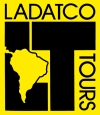

Destinations
Experiences
 |
L A
D A T C O T O U R
S |
 |
||||||||
| HOME | South America | Falkland Islands | Antarctica | Unique Destinations |
Unique Experiences |
Newsstand | ||||
|
Hacienda Zuleta Ecuador |
|
ABOUT THE COMMUNITY EMBROIDERY PROJECT AT HACIENDA ZULETA - in their own words:
Pre-Colombian Andean cultures boast a long tradition of weaving abilities, far surpassing those of Europe in the same era. The most talented weavers could produce material with as many as five hundred two-ply woolen wefts per inch. The highest figure attained in Europe before the industrial revolution was a mere one hundred.
Originally, traditional resources were used such as cotton and llama and alpaca wool to create complicated brocades, tapestries, double cloth and gauze. However, with the arrival of Spanish in the mid 1500's, new resources were introduced, such as silk embroidery yarns. The Zuleteņa women quickly incorporated these yarns into their weavings, and centuries later they are now renowned for their hand embroidery expertise, unique designs and colors. Zuleteņo embroidery was originally used to decorate the Zuleteņa women’s clothing. The style was so unique it actually became a form of cultural identification that has persisted to the present day, when so many folk arts are being lost.
Without doubt, this is in part due to former Ecuadorian president Galo Plaza Lasso and his wife Doņa Rosario, owners of Hacienda Zuleta from the 1940's. Doņa Rosario was inspired during one of her trips to Italy and Spain where in small villages she saw women embroidering on their doorsteps. On her return to Hacienda Zuleta, she proposed creating a workshop that would take advantage of the Zuleteņa women’s embroidery skills and produce articles for sale, as well as provide an additional income for the Zuleteņo homes.
This marked the beginning of the Zuleta Embroidery Workshop and the revitalization of hand-embroidered Zuleteņo textiles.
Children at the Galo Plaza Lasso School began receiving embroidery classes. Simultaneously, a group of women started working together at the Hacienda’s workshop. The result was hugely successful: the women created exquisitely embroidered tablecloths, blouses, placemats and towels, and family incomes were significantly increased. Less obvious, but of great cultural significance, the Zuleteņo people reaffirmed a true sense of community pride and realized the importance of preserving their unique craft.
In the early 1960’s Sr.Plaza obtained technical assistance from the Peace Corps to organize the workshop. Today there is a large group of women that earn a living from Zuleta Embroidery, some of who have independent workshops.Over the years the distinct Zuleteņo style hasn't changed. However, colors and applications have manifested themselves in new ways, thus providing a modern context for an ancient art form. Out of the original group of women that started the workshop a few still work at the Hacienda side by side with the next generation of Zuleteņo embroiderers. The aim of the workshop continues to be to supplement the basic agrarian income of the people in the surrounding communities, as well as to preserve the cultural tradition of the Zuleta Embroidery and Dress. The workshop is now managed under the auspices of the Galo Plaza Lasso Foundation as a social project benefiting over one hundred families in the Zuleta region.
All the products are completely hand-made in an effort to preserve the meaning “Cultural Heritage”. Zuleta Embroidery is indeed a tribute to the artistic talent of these women.
Today, the Zuleta embroideries can be found in many stores throughout Ecuador. Custom-orders are also available upon request.
Now the Foundacion does not longer run a workshop, but provides a place for merchandising. In our shop "El Taller" at the hacienda we exhibit and sell embroidery for the women from Zuleta and other involved comunities.Alternatively, you can visit our shop in Quito (Veintemilla y 6 de Diciembre). Bring the beauty of Zuleta emboidery into your own home!